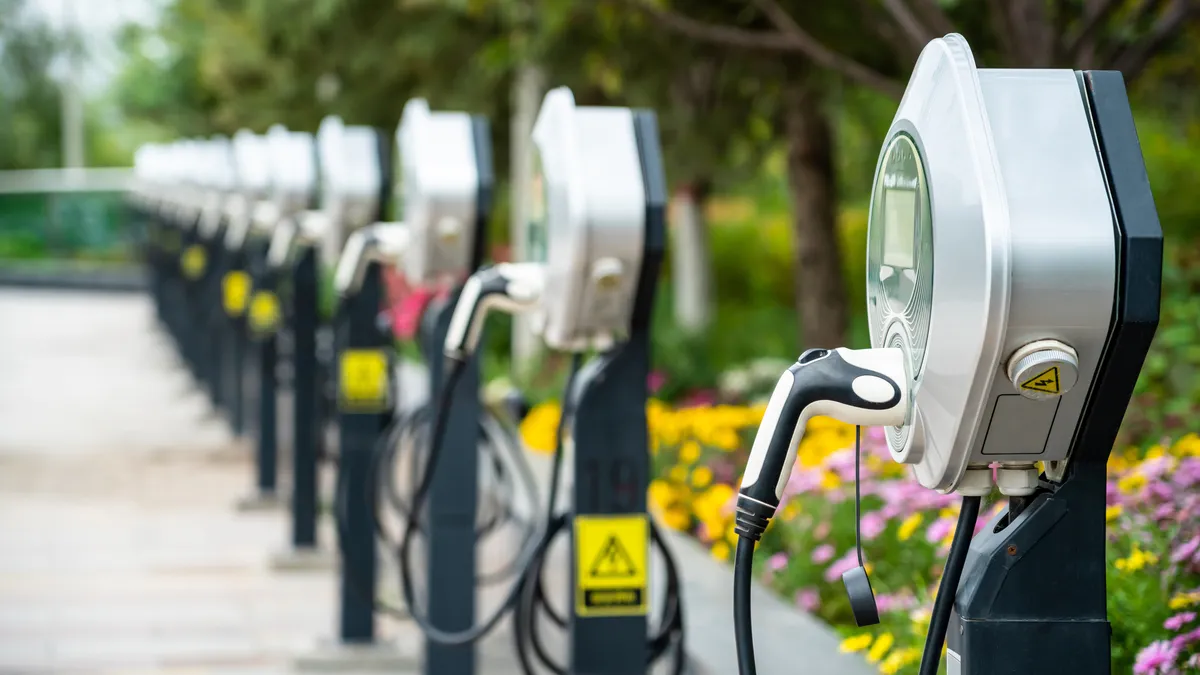Current headlines might seem to indicate that the electric vehicle craze was over before it got started.
Reports of EVs sitting on lots, cuts in production, cold weather issues and gripes about a lack of charging infrastructure have left many consumers with the impression that now is not the moment to switch from a gasoline-powered vehicle. At the same time, the Biden administration is pushing for greater adoption with clean vehicle tax credits and a goal of installing 500,000 chargers nationwide by 2030.
This change of events leaves multifamily operators with a conundrum: Continue to add charging stations on site or hold off?
For Aaron Luque, CEO at Atlanta-based EnviroSpark, an EV design, install and operations firm, not adding the infrastructure would be a mistake.

“For the past 10 years, we’ve been focused on building public-facing infrastructure at malls, restaurants, gas stations and other locations,” he told Multifamily Dive. “We need that and that’s where federal funding is going. But we’ve found the best place to install infrastructure in terms of bang for the buck is at home.”
EV drivers want the convenience of charging up at home, especially overnight, so that they don’t have to go to the mall or another public locale and kill time while they wait. For single-family homeowners, adding the infrastructure is relatively easy, but for the roughly one-third of Americans who rent their homes, that amenity is often out of their control.
Andres Pinter, co-CEO at Bullet EV Charging Solutions, based in Austin, Texas, said that, for the multifamily market, it’s about playing the long game.
“Historically EV drivers have been homeowners, but that is changing as EV prices come down and the next wave of younger EV drivers enters the market,” he said. “The early adopter phase is over, and now everyone is taking the leap into EV.”

As Pinter sees it, EV charging is the new laundry room, a necessary utility for many tenants. This especially holds true for new builds.
“EV charging is a must-have amenity for groud-up development,” he said. “Partly because it’s more cost-efficient to integrate and install charging into tenant parking during design and construction phases,” he said. “In fact, building code in many jurisdictions now requires a certain amount of EV charging.” For instance, in Atlanta, 20% of parking spaces in new multifamily development must be EV ready.
Luque said another reason to offer it is to attract the attention of tech-savvy, environmentally minded renters.
“The younger demographic wants to align with companies that align with their values,” he said. “When they find a community with EV charging, or plans to add it, they see a community that is environmentally focused.”
Charging ahead
While there’s truth in the fact that demand for EVs softened in 2023, Pinter said that overall 2024 will still be a bigger year of sales.
“Growth in new technology is rarely linear,” he said. “Despite demand tapering off at the end of 2023, EV sales were the highest ever in the U.S. last year. The EV share of the U.S. market was 7.6%, up from 5.9% in 2022.”
Adoption will also grow as consumers see more EV chargers pop up across the country. The Department of Transportation recently announced $623 million in grants to support charging infrastructure across the country.
"We're at a moment now where the electric vehicle revolution isn't coming, it is very much here," Transportation Secretary Pete Buttigieg said in announcing the grants.
This means that developers eyeing a new build or retrofit should still include EV charging, according to Pinter. In some cases, utility companies will offer incentives or rebates to multifamily developments, depending on the state. California Edison, for instance, offers up to $3,500 per charging port or $7,000 for a dual charging port.
“Multifamily is near and dear to our heart, and we want to generate awareness of EV ownership,” said Luque. “You can start easy, with one or two stations. The longer the station is there, the more EV drivers start using it, which adds value to your properties.”
The bottom line is that while news coverage about EV adoption may seem gloomy, don’t wager against the power of electric cars.
“Much of the multifamily market is already committed to electrifying their properties, and they shouldn’t slow down,” said Luque. “If you don’t have charging stations, you stand to lose a tenant or not recruit a new one.”











